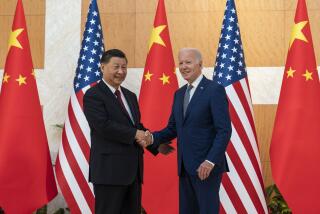Japan’s Immense Trade Surplus Conceals Exploitable Weaknesses : Economics: Washington should quit playing the beggar and leverage U.S. technological and market know-how into a better deal from Tokyo.
- Share via
To the amazement and delight of Tokyo bureaucrats, the astounding trade surplus Japan is racking up against the rest of the world has hardly caused a political ripple in the United States. After countless promises to equalize trade, and even as the recession continues to savage U.S. industry, Japan’s current account surplus with the United States in 1992 will likely exceed $45 billion--a 10% increase over last year. Its worldwide surplus may top $130 billion, a record no country has ever matched. Yet, America’s leaders seem unwilling to let the challenges posed by Japan intrude on our election-year obsession with politics.
One reason is that the Japanese policy debate has degenerated into a cliche-ridden stalemate. Apologists find excuses for virtually every Japanese practice, no matter how sharp, and insist that America should do nothing in response; critics contend that Japan is inherently incapable of fair dealing, and so managed trade or protectionism is the only way to react. Official U.S. strategy is to sternly lecture and beg for market-share concessions from a Japanese economic elite that increasingly holds America in contempt. Small wonder that no one--including President George Bush--has the stomach to challenge Japanese policy.
But the situation is not as hopeless as it seems. Paradoxically, Japan’s immense trade surplus conceals substantial vulnerabilities, because it is produced by further insulating the country’s economy from the rest of the world. Japanese firms do not form normal relationships with companies from other nations; they collaborate freely only among themselves. To keep their business networks vital, they must constantly import technologies and market information from overseas--especially from the United States. America can leverage its role as a source of information crucial to Japan and negotiate reciprocal access to Japanese technology and know-how, an outcome that would greatly improve economic relations between our countries.
Japan’s mounting trade surplus is chiefly the result of its insular economic structure, which responds to global market slumps by causing imports to fall precipitously while exports remain steady or increase. Imported products in Japan--from cars to ketchup--are subject to huge price markups, forcing Japanese consumers to treat them as luxury items. As soon as money gets tight, imports are scratched from their budget. That’s why Japanese imports have fallen about 6% a quarter during the past year and a half.
At the same time, exports haven’t appreciably decreased because Japan’s overseas trade is dominated by subsidiaries of its largest companies, most of which have excess capacity at home. Unlike foreign affiliates of other nations’ firms, which typically integrate into local economies where they do business, Japanese subsidiaries are compelled to buy parts and services from their corporate parents in Japan.
Marginalizing imports and internalizing trade within networks of affiliated multinational firms may seem an unbeatable strategy, but an insular economy carries a hidden price. As markets increasingly diversify, and consumers seek custom goods and services that they can mix and match on their own, success in global markets hinges on developing specialized products that can be easily linked with others. To do this, a producer must intimately understand each of its customer’s needs, and also ensure that its products are “open” enough to be used in several potentially diverse applications. Yet, Japanese firms do not become part of the regular exchange of technological, market and product information that normally occurs among other companies in the world.
It’s hard to maintain a closed economy without losing touch with global micromarkets and the design standards or clever applications other firms are pursuing. Japanese firms thus run the risk of not anticipating creative innovations and of falling chronically behind producers in other nations. Alternatively, Japanese designers may construct a product that is versatile and effective, but because it cannot be linked with anyone else’s equipment, customers will actually buy less sophisticated, more flexible products.
In the past, these problems weren’t especially severe because Japanese manufacturers collaborated among themselves much more effectively than other nations’ firms. As Japan’s enormously talented smaller- and medium-sized companies continuously expanded their industrial alliances with each other, they created networks of specialized, flexible producers, made quality products and diversified markets more readily than anyone else.
Production collaboration, however, is no longer news to Asian, European and U.S. companies. Even as these firms construct their own networks, there are signs that Japan may be reaching the limits of its closed economy.
Many of Japan’s larger companies, for example, have been stripped of their technologies--and their profits--by their suppliers. They are looking, thus far without success, to find new domestic partners to rebuild their skills. Traditional alliances are also proving too limited for Japan’s most talented suppliers, who want to find dynamic collaborators to further develop their capabilities. But because new start-up companies are now rare in Japan, and smaller Japanese firms are notoriously leery of foreigners, they continue to rely on Japan’s multinationals for global access and recycle their increasingly stale relationships at home.
To avoid stagnation, Japan must continually feed knowledge gleaned from abroad into its domestic business networks. Europeans generally view Japanese collaboration with suspicion, and despite Japan’s investments throughout Asia, Japanese leaders dismiss the possibility they might learn from the region. Only the United States, with its tradition of openness, can provide Japanese firms with the cutting-edge technologies and market information they require.
Washington thus has an opportunity to reduce bilateral-trade inequities by insisting that Japanese firms sell or license their technologies before they can obtain information or do business in America. For instance, if a Japanese company wants to buy sophisticated electronic technologies from a struggling U.S. defense contractor, it must also let the U.S. firm buy, at a reasonable cost, its know-how or license or produce one of its major products. This “offset” strategy is, in fact, right out of Japan’s economic playbook: For decades, the Japanese have not bought foreign aircraft, cellular telephones or medical equipment without receiving technology licenses and opportunities to manufacture or design key components in return.
The United States needs a national technology policy because our domestic firms, especially during a recession, will otherwise have little ability or incentive to negotiate for Japanese technologies or manufacturing licenses on their own. It also avoids our unfortunate role as supplicant for economic concessions from Japan, a posture that frequently trades U.S. technologies for Japan’s promises to open fractional shares of its domestic market. Finally, by focusing on offsets to equalize information and trade flows between the two countries, a technology policy would avoid more draconian--and potentially destabilizing--protectionist measures.
Despite the harrowing trade statistics, the United States does have policy options that can facilitate mutually beneficial economic exchanges with Japan. Even as Japan’s trade surplus mocks years of bilateral negotiations, however, many doubt that America will develop strategies to effectively promote its global economic interests. Perhaps, in this election year, it’s time to take stock of our strengths and prove the skeptics wrong.
More to Read
Inside the business of entertainment
The Wide Shot brings you news, analysis and insights on everything from streaming wars to production — and what it all means for the future.
You may occasionally receive promotional content from the Los Angeles Times.










